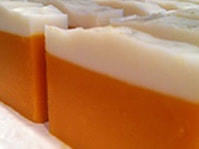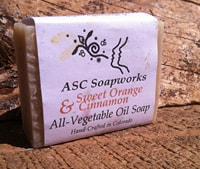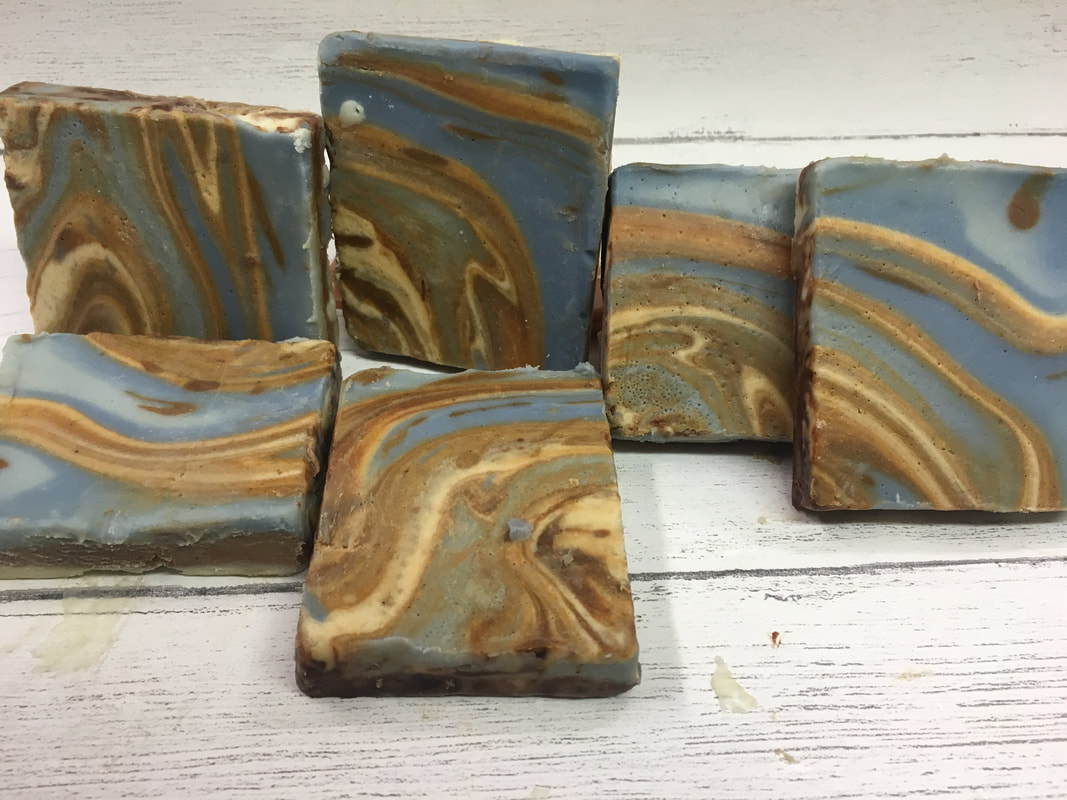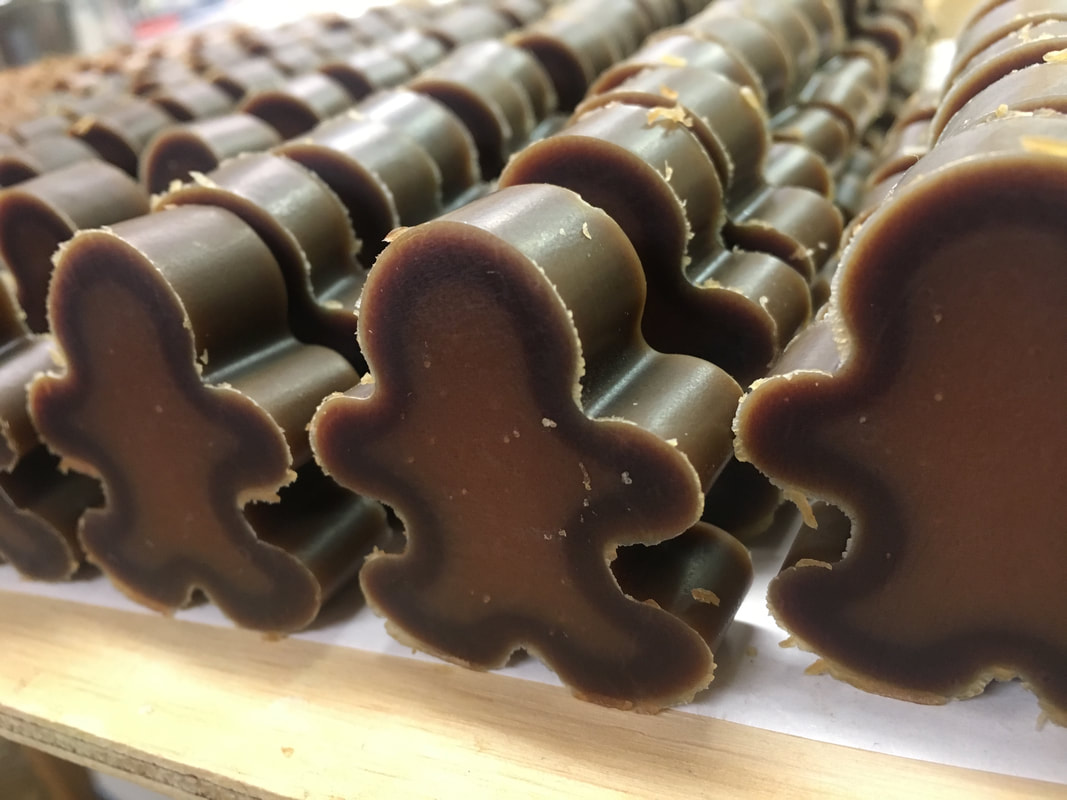|
Our philosophy here at ASC Soapworks, is to keep it simple. We make soaps that are great for all people, including those with skin sensitivities,and the simpler the better.. Most of our soaps, therefore, come in their unadulterated form, generally a cream color. These unsullied bars will still have some variation depending on the essential oil and/or fragrance used, as well as other ingredients that are sometimes added. The basic nature of the soap making process is fairly harsh on many additives making coloring more difficult than one would initially think. However, if you have a fundamental understanding of chemistry, this can not only be maneuvered around, but used to your advantage. Alkanet root infused oils are very much like a litmus paper. It will be red until the base is added, then turning a vibrant purple. Anything with a bit of vanilla will have a natural brown color, as is the case if there are sugars in the recipe, like honey, milk of any kind, etc. Beautiful lavender buds will turn brown as they go through the saponification process. Ensuring that the soap goes through a gel phase will help to deepen the color and to make them more consistent throughout. Many ingredients sold for coloring soaps are considered to be "natural" - titanium dioxide, micas and oxides are some examples. However, going with the thought that less is more, these are not added to our recipes. We prefer to add ingredients that we would naturally ingest, or grow in the garden. This is just our preference. So what do we add, you ask? Let's take a walk through the rainbow to find out. Reds and Pinks It is difficult to obtain a true "American flag" red using natural colorants in soap. A couple of different clay products give us acceptable alternatives. The Burlap & Lace soaps that I have made would fall in the red spectrum, but they are more of a brick red, a little on the orange side. Making this batch utilized Moroccan red clay, added at trace. The Candy Cane soaps, along with a few other varieties I have created, are made using Rose Clay, and you can get a very nice gradient of pinks, almost closing in on red. Because of this, rose clay has been my favorite when I need something in the field of red. In the photos below, you can see the difference in the rose on top of the soap (rose clay) and the background color of the soap (Moroccan red clay) in the Burlap and Lace Soap on the left. The other three soaps were created with rose clay. While researching how to make red soaps using natural products, it is apparent that many people use madder root with success. It apparently can be added at trace, or to the lye solution. I have been reluctant to experiment with this material for a few reasons. I have read that it should not be used in baby products, Wikipedia states that in folk medicine is has been used to induce miscarriages and that it may cause birth defects. It has not been approved as a colorant by the FDA, and I wonder if all of these facts play into why. Madder root is not something you will find in our soaps, as there is no need to add anything with a questionable background. Oranges and Yellows There are many ways to create beautiful oranges and yellows in soaps naturally - annatto seed, calendula, chamomile, carrots, cornmeal, orange, paprika, safflower petals, saffron and turmeric are all popular. You can add color through oil infusion or by adding powder or puree at trace, adding it to lye, etc.. Paprika is found in both the Sweet Orange & Cinnamon and the Rose Patchouli bars, and I choose to add at trace most of the time, generally out of ease of use and spontaneity. Coloring the soap in this manner may add a very light exfoliating effect due to the grainy texture of the powder or larger pieces puree. Annatto seed is a natural, alternative food coloring that can be found in products such as cheeses or natural macaroni & cheese, crackers, etc. You can find it fairly cheaply in Hispanic groceries, also known as achiote, as they use it in recipes involving the marinating of meat and chicken, as well as soups and other dishes. It is available in both a powdered form and whole seeds. The Clove Bar is a beautiful orange color, achieved by infusing oil with this seed. The resulting oil is then added to the recipe in varying amounts to obtain the desired color. Depending on how much is used, the resulting soap can be anywhere from a very pale yellow to a deep orange. Infusing the oils is preferable if you are not a fan of the grainy texture that arises from adding the powder at trace. Greens Although many additives have been attempted, greens have been a bit elusive. The easiest and most consistent has been using Green Sea Clay. I like the color, but it is a deeper green, darker and grayish. This color works for some applications, but if trying for the green of grass, or a shamrock, it just doesn't give the same effect. It would be reasonable to think that you could combine the sea clay with annatto, but it doesn't really change the color satisfactorily. Nettle leaf infused oils have been too weak, giving a washed out color. In order to get a decent shade of green from Spirulina, a fairly large amount needed to be used, and the resulting soap gave off an odor that was not masked well by the essential oils used. This was not a very desirable outcome. The most recent foray into creating a green soap has been using liquid chlorophyll. The first batch was very promising, as the color was perfect, and it was extremely easy to use, adding it at trace until reaching the desired shade. However, after a few weeks, it faded away to a light brown color. Since then, I have been playing with a few different things to see if the color will be retained better. The results are still to be seen. Blues and Purples Blues, once again, are difficult colors to obtain. Indigo is the "go to" colorant in the industry, and it can be added at trace or to the base solution. Again, you need to add a significant amount to get a true blue. This then poses another problem - the fact that indigo is an industrial dye that stains. Not exactly what you want in a soap. I have used it a few times, trying to add it in various ways, but at the concentrations that I have used, the color tends to fade away quickly to more of a gray tone. Purples, on the other hand, are easily obtained using an oil infused with alkanet root. To get a deeper color, substitute 40-50 % of the oils with the infused oil, use less for lighter shades. Some success has been found with adding small amounts of infused oil at trace to color the soap batter. The result of this is a much lighter shade, but purple nonetheless. Easy to use, with a little bit of forethought, alkanet root lends a beautiful shade to your soap color palette. Blacks and Browns Charcoal is an effective ingredient to create shades of black and gray in soaps and has been touted as having the added benefit of drawing toxins from the skin. This is what we use when looking for the sleekness and style that black adds to a design. Some people use poppy seeds for specks - they are perfectly natural, and I love the speckled look. Caution needs to be used when using non-soap additives, even though we incorporate lavender buds, cornmeal, coffee and oatmeal into some of our bars. Since reading about aduki beans growing in people's showers, I try to steer away from anything that will grow or clog up the shower drain. My husband doesn't like to use the Simply Lavender bar for this exact reason, but customers do like the exfoliating nature of the additives, so I keep a few varieties in the line with that feature. I may try the poppy seeds at some point in time, as they are aesthetically pleasing, and from where I stand, they are harmless enough. Browns can be created many ways, as much of what you start with will turn brown when added to the basic soap batter. However, for intentionally creating brown, our favorite is cocoa. We also use cinnamon in our shampoo bar, and of course the coffee bar utilizes its namesake for its brown shade. Have you ever had a chocolate body wrap at a spa? It's supposed to be an awesome experience, as is washing up with chocolate! Love it :) This article should provide insight into some aspects of design for our artisan soaps. If you have any questions or comments, please feel free to comment below.
0 Comments
|
Details
TaralynColorado Artisan, making beautiful hand-crafted soaps with all natural ingredients. Archives
August 2025
CategoriesCategories
Comment Policy
We follow Grandma's rule here: If you don't have something nice to say, don't say anything at all. While constructive criticism is always welcome, keep it polite, considerate and friendly. These are simple rules that, if not followed, will result in the deletion of the comment. Thank you. |
|
|
Our soaps and body care products are handcrafted the old-fashioned way, in Boulder County, Colorado by your local Soap Making Artist, Taralyn. Small artisan batches allow for considerable attention to detail during all stages - soap making, hand cutting, six week cure time and hand wrapping - an extensive journey that nurtures the formation of the perfect bar of luxury soap. And to make it even better, we will deliver to your door! Shop by Signature or Artisan, by scent families, ingredients or by name. So much to explore! Check out our collections today!
|
Contact
|
About
Get to Know Your Soap Maker!
|
Customer Service
ASC Creative Credits
|
Other Goodies
Community Connection Blog
Wild Rovings Blog
Why Palm Oil?
Organic Label
|
Copyright © 2009-2025 ASC Soapworks, llc, All rights reserved.






















 RSS Feed
RSS Feed

